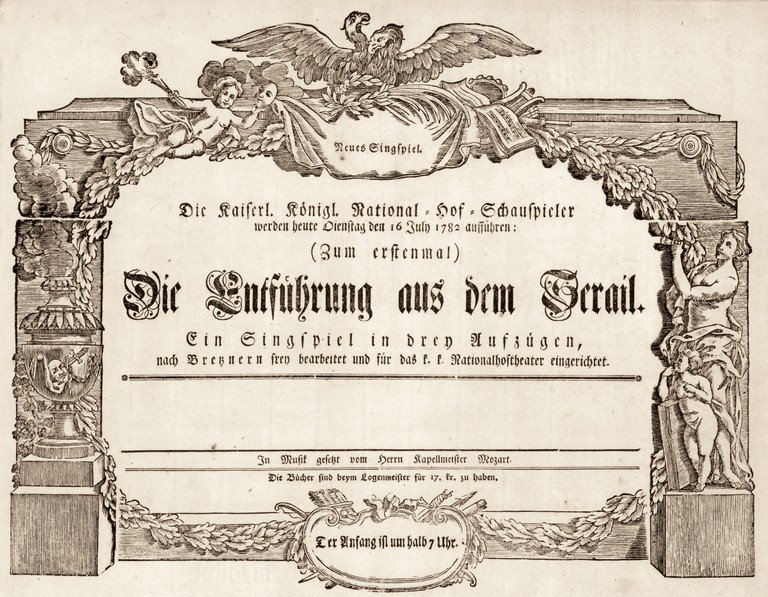Singspiel (text: Gottlieb Stephanie) in two acts first performed at the Burgtheater, Vienna, on 16 July 1782.
Based on Belmont und Constanze, oder die Entführung aus dem Serail, an earlier text by Christoph Friedrich Bretzner, Mozart’s setting was commissioned for the National Theatre in 1781; he received the libretto on 30 July of that year. Originally intended for performance during a forthcoming visit to Vienna by Grand Duke Paul of Russia, the production (and as a result some of the composition of the opera) was postponed to the following spring. On 30 January 1782 Mozart wrote to his father, ‘The opera hasn’t fallen asleep, but has been postponed owing to the big Gluck operas and to many very necessary alterations in the text; but it is to be given just after Easter.’
In a letter of 26 September, Mozart gives a vivid description of his opera aesthetic, and details of his compositional thinking:
- . . . in the original libretto Osmin has only [a] short song and nothing else to sing, except in the trio and the finale; so he has been given an aria in act I. . . I have explained to Stephanie the words I require for the aria [‘Soche hergelaufne Laffen’]—indeed I had finished composing most of the music for it before Stephanie knew anything about it. I am enclosing only the beginning and the end, which is bound to have a good effect. Osmin’s rage is rendered comical by the use of the Turkish music. In working out the aria I have . . . allowed Fischer’s beautiful deep notes to glow. The passage ‘Drum beim Barte des Propheten’ is indeed in the same tempo, but with quick notes; and as Osmin’s rage gradually increases, there comes (just when the aria seems to be at an end) the allegro assai, which is in a totally different metre and in a different key; this is bound to be very effective. For just as a man in such a towering rage oversteps all the bounds of order, moderation and propriety and completely forgets himself, so must the music too forget itself. But since passions, whether violent or not, must never be expressed to the point of exciting disgust, and as music, even in the most terrible situations, must never offend the ear, but must please the listener, or in other words must never cease to be music, so I have not chosen a key foreign to F (in which the aria is written) but one related to it—not the nearest, D minor, but the more remote A minor. Let me now turn to Belmonte’s aria in A major, ‘O wie ängstlih, o wie feurig’. Would you like to know how I have expressed it—and even indicated his throbbing heart? By the two violins playing in octaves. This is the favourite aria of all those who have heard it, and it is mine also. I wrote it expressly to suit Adamberger’s voice. You see the trembling—the faltering—you see how his throbbing breast begins to swell; this I have expressed by a crescendo. You hear the whispering and the sighing—which I have indicated by the first violins with mutes and a flute playing in unison.

Poster for the first performance of Die Entührung aus dem Serail, July 1782
Die Entführung premiered at the Burgtheater on 16 July 1782 and was well-received. A reviewer in the Litteratur- und Theaterzeitung (Berlin) for 5 October 1782 wrote that ‘it has an extraordinary amount of happily inspired song.’ Among all Mozart’s operas, Die Entführung was the most frequently performed, not only in Vienna but across German-speaking Europe. An early obituary in the Musikalische Korrespondenz der teutschen Filarmonischen Gesellschaft, published at Speier on 4 January 1792, described it as ‘the pedestal upon which Mozart firmly erected his fame.’